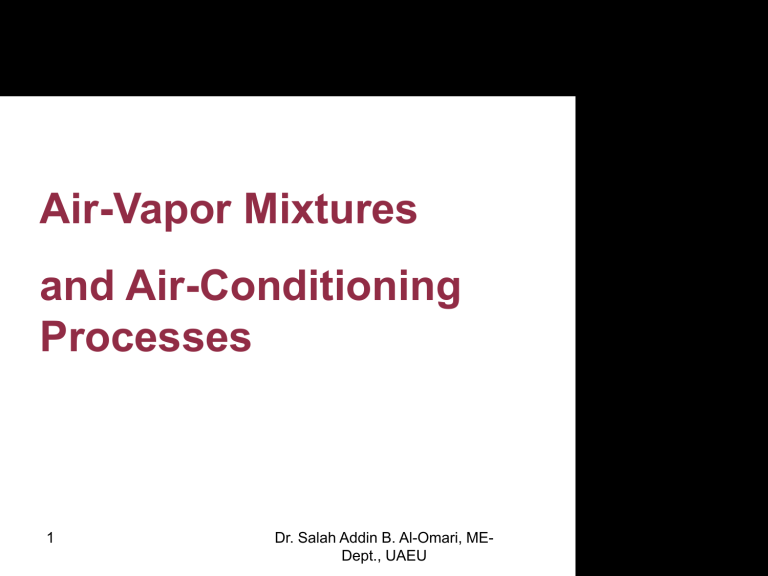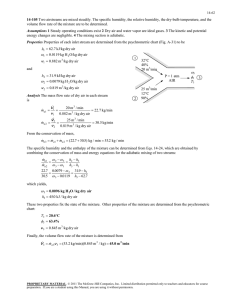
Air-Vapor Mixtures and Air-Conditioning Processes 1 Dr. Salah Addin B. Al-Omari, MEDept., UAEU Lecture Objectives: To give introduction and basic background material for Air Conditioning Applications 2 Dr. Salah Addin B. Al-Omari, MEDept., UAEU Learning Outcomes: Students will be able to: • Understand important terminology such as: humidity ratio, relative humidity, wet bulb and dry bulb temperature. • Calculate quantities for air-vapor mixtures such as the dew point temperature, relative humidity and humidity ratio. • Do mass and energy balance for air conditioning processes and apply these to important applications. • Use the psychrometric chart to obtain properties of air-vapor mixtures. 3 Dr. Salah Addin B. Al-Omari, MEDept., UAEU Part 1 4 Dr. Salah Addin B. Al-Omari, MEDept., UAEU Assumption for the Specific heat of air in A/C applications The Cp of air can be assumed to be constant at 1.005 kJ/(kg · °C) in the temperature range -10 to 50°C with an error under 0.2 percent. This range (from - 10 to 50°C) is the one considered in A/C applications. So, this assumption of constant Cp will be valid in what follows. 5 Dr. Salah Addin B. Al-Omari, MEDept., UAEU Dry air, unsaturated air-vapor mixture, and saturated air-vapor mixture Preliminary Remarks: It is reasonable to consider air and vapor to behave like ideal gases; Dry Air contains no water vapor, but atmospheric air does. Pair vapor mixture = Pdry air + Pvapor OR in short notation P = Pa + Pv where: Pv is the partial pressure (or simply vapor pressure) of water vapor in atmospheric air. 6 Dr. Salah Addin B. Al-Omari, MEDept., UAEU Dry air, unsaturated air-vapor mixture, and saturated air-vapor mixture This value is taken form Table A-4 in your textbook of Cengel For saturated air, the vapor pressure is equal to the saturation pressure of water at the given temperature of the air-vapor mixture; SEE Above Figure. 7 Dr. Salah Addin B. Al-Omari, MEDept., UAEU Assumption for the Specific enthalpy of the vapor in the air-vapor mixture Recall: the specific enthalpy of an IDEAL GAS is a function of Temperature ONLY. The region where the vapor behaves like an ideal gas is enclosed by dotted circle lines. So, inside this circled region lines of constant temperature, are also lines of constant enthalpy; (whenever the temperature remains constant, so does the enthalpy for IDEAL GASES. Outside this circled region, the vapor cannot be considered as ideal gas specific enthalpy is not only a function of Temperature, BUT also, of pressure. 8 Dr. Salah Addin B. Al-Omari, MEDept., UAEU Assumption for the Specific enthalpy of the vapor in the air-vapor mixture For low the vapor in the circled region (in which the vapor behaves like and ideal gas) we can take hvapor at any temperature below 50oC to be as: hv (at T) = hg(T) See FIGURE; At temperatures below 50C, the h = constant lines coincide with the T = constant lines in the superheated vapor region of water. This range of temperature is the one relevant for A/C applications. SO, for Superheated vapor at low pressure (i.e. low partial pressure of vapor) at T below 50oC, we can treat vapor as IDEAL GAS This will be our assumption in the material to follow on Air Conditioning. 9 Dr. Salah Addin B. Al-Omari, MEDept., UAEU Some important notes on Ideal Gas Mixtures Recall for ideal gas mixtures : all components in the mixture have the same volume as that of the mixture For Air Vapor mixture we have : Vvapor Vair Vm ixture Since we talk of Ideal Gas Mixtures, we can apply the ideal gas equation of state for each gas component in the mixture Pdry airVair mdry air RairTair PvaporVvapor mvaporRvaporTvapor 10 Vvapor Vair Vmixture V Dr. Salah Addin B. Al-Omari, MEDept., UAEU Important NOTE for Flow Systems For a flow of ideal gas mixtures : all components in the mixture have the same volume as that of the mixture For Air Vapor mixture we have : Vvapor Vair Vmixture Pdry airVair m dry air RairTair PvaporVvapor m vapor RvaporTvapor Vvapor Vair Vmixture V 11 Dr. Salah Addin B. Al-Omari, MEDept., UAEU Specific Humidity (or the humidity ratio: ) Specific humidity (or humidity ratio): = mv /ma Using the ideal gas equation of state for both the Pdry airV mdry air RairTair vapor and for dry air PvaporV mvaporRvaporTvapor = 0.622 Pv / Pa = 0.622 Pv / (P – Pv) Remember: P in the above equation is the total pressure of the air+vapor mixture = Pa +Pv 12 Dr. Salah Addin B. Al-Omari, MEDept., UAEU Relative Humidity: Relative humidity: Pv Pg where: Pg is the saturation pressure of water at temperature Tmixture. Also this means: Pg is the partial pressure of water vapor when the Air+Vapor mixture is fully saturated with water vapor @ Tmixture. 13 Dr. Salah Addin B. Al-Omari, MEDept., UAEU Relative Humidity: Also we can express relative humidity in terms of mass ratio as : mv mg mv: is the actual mass of vapor in the air-vapor mixture. mg is maximum vapor mass that the air can hold at a given temperature This happens when the air is fully saturated with vapor. At that condition of maximum vapor mass content in the air, the partial pressure of vapor id the saturation pressure of water at the given temperature of the mixture. 14 Dr. Salah Addin B. Al-Omari, MEDept., UAEU Relative Humidity: REMEMBER that we can apply the IDEAL GAS Equation of STATE for the Vapor both at the actual condition as it exists in the air/vapor mixture, AND also at the condition of full saturation (i.e. when the vapor mass content in the air is maximum; mg,max). This means: PvV mv RvaporTairmixture Pg ,sat @TairmixtureV mg ,max RvaporTairmixture By dividing the above two equations we can show that: mv Pv m g Pg 15 Dr. Salah Addin B. Al-Omari, MEDept., UAEU Relative Humidity: Important note: mv Pv m g Pg Note: in the above equation mg represents the maximum vapor mass the air can hold at a certain temperature (i.e. at the saturation condition). So, if you try to inject water vapor into the saturated air+vapor mixture, the vapor will not stay as gas, but will fall down as liquid (i.e. Cannot be held in the mixture as gas), BECAUSE THE MIXTURE IS SATURATED ALREADY WITH VAPOR. 16 Dr. Salah Addin B. Al-Omari, MEDept., UAEU Important Notes Relative humidity () ranges from 0 to 1 (0% to 100%) For saturated air = 100% For dry air = 0% Any water vapor added to a saturated air at a given temperature will condense. 17 Dr. Salah Addin B. Al-Omari, MEDept., UAEU Example Consider a room filled with air vapor mixture with the following data: P = 101 kPa; T=23oC; Dimensions: 10m x 6m x 3.5m Relative humidity: 60 percent. 1.Is the air/vapor mixture saturated? Justify your answer! Determine: 2.The partial pressure of water vapor in the room. 3.The mass of dry air in the room. 4.The specific humidity. 5.The humidity ratio. 6.The Partial pressure of dry air. 7.The mass of vapor in the room. 18 Dr. Salah Addin B. Al-Omari, MEDept., UAEU Important NOTE for Flow Systems If you have a flow system for air+vapor mixture, you can ALSO write the humidity ratio equation in terms of flow rate quantities, as: m v m v m a m a Similarly, you also can write the ideal gas equation of state in terms of flow rate quantities: 19 Dr. Salah Addin B. Al-Omari, MEDept., UAEU Example Consider a steady flow of ideal gas mixture with the following data: P = 101 kPa; T=23oC; Relative humidity: 60 percent. Flow rate is 10 m3 /min Determine: 1. The partial pressure of dry air and that of water vapor. 2. The humidity ratio. 3. The mass flow rate of the water vapor. 20 Dr. Salah Addin B. Al-Omari, MEDept., UAEU Recall: Putting the Ideal Gas Equation of State in terms of Time-rate Quantities: Below relations are valid as long as we have justified reason to assume IDEAL GAS Mixture. Pdry airVair m dry air RairTair PvaporVvapor m vapor RvaporTvapor Vvapor Vair Vmixture V 21 Dr. Salah Addin B. Al-Omari, MEDept., UAEU End of Part 1 22 Dr. Salah Addin B. Al-Omari, MEDept., UAEU Enthalpy of Air-Vapor Mixture H = Ha + Hv = ma ha + mv hv mv recall : ma Divide the above equation by the mass of dry air (ma) h = H / ma = ha +mv hv / ma = ha + hv But (as mentioned earlier) at low pressures for temperatures below 50 oC, hv is approximately = hg at the given temperature h ha hg Unit of h is : J/kg dry air 23 Dr. Salah Addin B. Al-Omari, MEDept., UAEU Summary of the moist Air Relations Recall: The enthalpy of moist (atmospheric) air is expressed (by convention; (or by definition) per unit mass of dry air, NOT as the usual practice we adopted so far by considering the total mass of the system (in this case the total mass of the moist air mixture). 24 Dr. Salah Addin B. Al-Omari, MEDept., UAEU Dew-Point Temperature of Air-vapor mixture Dew-Point Temperature: the temperature at which condensation begins when the air is cooled at constant pressure. Pv Pv Pg Pg where : Pg Psat @Tair Vapor mixture ; from Table A - 4 Then : Tdew Tsaturation @ Pv ; From Table A - 5 25 Dr. Salah Addin B. Al-Omari, MEDept., UAEU Example on Dew-Point Calculations EXAMPLE: Moist air with relative humidity of 60% at a temperature of 30oC. What is its dew-point temperature? 26 Dr. Salah Addin B. Al-Omari, MEDept., UAEU Solution of the Dew-Point Temperature Example Pv Pv Pg Pg where : Pg Psat @T o air Vapor mixture 30 C from Table A - 4 : Psat @T o air Vapor mixture 30 C 4.2469 kPa; Pv 0.6 4.2469 2.548 kPa Table A 5 @ Pv 2.548 kPa Tsat @ Pv 21.2o C Tdew point tem perature Note: later we will use Chart to solve the above example, instead of equations. 27 Dr. Salah Addin B. Al-Omari, MEDept., UAEU Example Consider a room filled with air vapor mixture with the following data: P = 101 kPa; T=23oC; Dimensions: 10m x 6m x 3.5m Relative humidity: 60 percent. 1.Is the air/vapor mixture saturated? Justify your answer! Determine: 2.The partial pressure of water vapor in the room. 3.The mass of dry air in the room. 4.The specific humidity. 5.The humidity ratio. 6.The Specific enthalpy of the mixture per unit mass of dry air. 7.The dew point temperature. 8.The Partial pressure of dry air. 9.The mass of vapor in the room. 28 Dr. Salah Addin B. Al-Omari, MEDept., UAEU Wet-Bulb Temperature FIGURE A simple arrangement to measure the wet-bulb temperature. Note 1: Using a simple thermometer without having its bulb covered with a cotton wick soaking water we measure what is called the “dry bulb temperature”. Note 2: When we measure the wet bulb temperature using the setup shown in the Figure, the air surrounding the cotton wick is fully saturated with water vapor; i.e. it has relative humidity ϕ= 100% 29 Dr. Salah Addin B. Al-Omari, MEDept., UAEU The Psychrometric chart. This is the chart that gives the thermo physical properties of air + vapor mixtures, such as: The specific enthalpy (per unit mass of dry air), the dry and wet bulb temperatures, the relative humidity, the humidity ratio, the specific volume, and the dew point. FIGURE Schematic for a psychrometric chart. 30 Dr. Salah Addin B. Al-Omari, MEDept., UAEU Psychrometric Chart for Air+Vapor mixture at a pressure of 101.325 kPa 31 Dr. Salah Addin B. Al-Omari, MEDept., UAEU More detailed Psychrometric chart (Available in your book) FIGURE Actual psychrometric chart for air+vapor mixture at total mixture pressure of 101 kPa. 32 Dr. Salah Addin B. Al-Omari, MEDept., UAEU Air-Conditioning Processes FIGURE Various airconditioning processes. 33 Dr. Salah Addin B. Al-Omari, MEDept., UAEU Example Repeat the previous example BUT use the psychrometric Chart, instead of the equations. Compare between your results based on the chart and those based on the equations. Consider a room filled with air vapor mixture with the following data: P = 101 kPa; T=23oC; Dimensions: 10m x 6m x 3.5m; Relative humidity: 60 percent. Determine: 2.The partial pressure of water vapor in the room. 3.The mass of dry air in the room. 4.The specific humidity. 5.The humidity ratio. 6.The Specific enthalpy of the mixture per unit mass of dry air. 7.The dew point temperature. 8.The Partial pressure of dry air. 9.The mass of vapor in the room. 34 Dr. Salah Addin B. Al-Omari, MEDept., UAEU EXAMPLE on Use of the psychrometric chart Consider a room that contains air at 1 atm, 22oC and 40% relative humidity. Using the psychrometric chart, determine: 1. The humidity ratio (specific humidity). 2. The enthalpy (per unit mass of dry air). 3. The wet-bulb temperature. 4. The dew-point temperature. 5. The specific volume of the air. HW: repeat the solution of the above example, BUT use Equations; NOT the psychrometric chart. Compare the results of both approaches!! 35 Dr. Salah Addin B. Al-Omari, MEDept., UAEU Air-Conditioning Processes: Mass Balance 1 2 FIGURE During simple heating, specific humidity remains constant, but relative humidity decreases. Dry air mass balance : Water mass balance: m a ,in m a ,exit m w,in m w,exit Water mass balance can also be written as : m a ,in in m a ,exit exit 36 Dr. Salah Addin B. Al-Omari, MEDept., UAEU Keep in mind: During simple heating in = out Air-Conditioning Processes: Energy Balance Steady Flow Energy Balance gives (1st law) : Q in W in m in hin Q out W out m exit hexit For simple heating Q m h h in a exit in For simple cooling Q m h h out 37 a in exit Dr. Salah Addin B. Al-Omari, MEDept., UAEU EXAMPLE on Simple Heating Processes; part of example 14-6 An air-conditioning system is to take outdoor air at 10oC and 30% relative humidity at steady rate of 45 m3/min and condition it to 25oC without adding any moisture to it . Determine: 1. What do we call this kind of air conditioning process? 2. The relative humidity at the exit. 3. The humidity ratio at the exit. 4. The rate at which heat is added to the air. 5. Show the process on a psychrometric chart. 6. Solve this problem in two ways: using the psychrometric chart and using the basic relevant equations. 38 Dr. Salah Addin B. Al-Omari, MEDept., UAEU Air-Conditioning Processes: Simple Cooling FIGURE During simple cooling, specific humidity remains constant, but relative humidity Increases. 39 Dr. Salah Addin B. Al-Omari, MEDept., UAEU EXAMPLE on Simple Cooling Processes An air-conditioning system is to take in outdoor air at 30oC and 50% relative humidity at steady rate of 45 m3/min and condition it to the lowest temperature possible while maintaining a simple cooling process. Determine: 1. The dry bulb and wet bulb temperatures at the exit. 2. The humidity ratio at the exit. 3. The relative humidity at the exit. 4. The rate at which heat is added to the air. 5. Show the process on a psychrometric chart. 6. Solve this problem in two ways: using the psychrometric chart and using the basic relevant equations. 40 Dr. Salah Addin B. Al-Omari, MEDept., UAEU Air-Conditioning Processes: Simple Heating with Humidification FIGURE Simple Heating with Humidification It consists of two stages: • Simple Heating from 1 to 2 • Heating while humidifying from 2 to 3 41 Dr. Salah Addin B. Al-Omari, MEDept., UAEU EXAMPLE on Simple Heating with humidification An air-conditioning system is to take in outdoor air at 10oC and 30% relative humidity at steady rate of 45 m3/min and to condition it to 25oC and 60% relative humidity. The outdoor air is first heated to 22oC in the heating section. Assuming the entire process takes place at a pressure of 100 kPa, determine: 1. The rate of heat supply in the heating section and 2. The mass flow rate of the steam required in the humidifying section. 3. At which temperature should the water be injected in the humidification section? 42 Dr. Salah Addin B. Al-Omari, MEDept., UAEU Air-Conditioning Processes: Simple Cooling with Dehumidification FIGURE Simple Cooling with Dehumidification It consists of two stages: • Simple cooling from 1 to the saturation line (see Fig.) • Cooling while DEhumidifying to point 2 (see Fig.) 43 Dr. Salah Addin B. Al-Omari, MEDept., UAEU Air-Conditioning Processes: Simple Cooling with Dehumidification IMPORTANT NOTE You can NOT jump directly from point 1 to point 2 along a straight line; in this kind of dehumidification process you MUST reach first the saturation point then dehumidification (i.e. condensation) starts while the temperature drops until you reach the desired point 2. 44 Dr. Salah Addin B. Al-Omari, MEDept., UAEU Air-Conditioning Processes: Simple Cooling with Dehumidification Another IMPORTANT NOTE The condensation (i.e. dehumidification process) does not take place at a fixed temperature; but at a range of temperatures from the saturation (or dew point temperature) to the final point (point 2). An average temperature between these two temperatures can be used in calculations as an approximation. 45 Dr. Salah Addin B. Al-Omari, MEDept., UAEU EXAMPLE on Simple Cooling with Dehumidification Air enters a window air conditioner at 1 atm, 30oC, and 80% relative humidity at a rate of 10 m3/min, and it leaves as saturated air at 14oC. As a matter of simplification of the analysis, consider that the moisture in the air that condenses during the process is also removed at 14oC. Determine: 1. The rate of heat removal from the air. 2. The rate of mass removal from the air. 46 Dr. Salah Addin B. Al-Omari, MEDept., UAEU Continued Psychrometric chart FIGURE For saturated air, the dry-bulb, wetbulb, and dewpoint temperatures are identical. 47 Dr. Salah Addin B. Al-Omari, MEDept., UAEU



